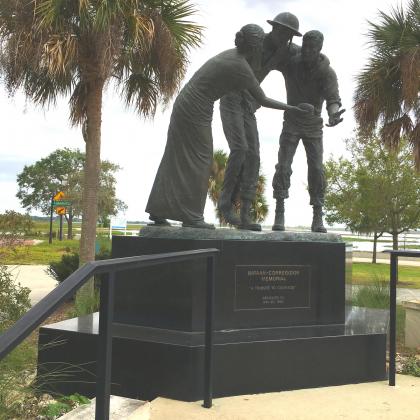Since it was dedicated in 1995, tens of thousands of people visiting Kissimmee Lakefront Park have seen the bronze statue of three figures in the northeast corner of the park.
One is a woman, another obviously a soldier, all three huddled in distress. This scene depicts a Filipina woman, a Filipino soldier, and an American soldier in the horrific story of the Bataan Death March, a brutal consequence of the American defeat in the Philippines in the opening days of World War II.
The United States gained control of the Philippine Islands from Spain, at the end of the Spanish-American War of 1898. The islands occupy a strategic location in Asia, and a large U.S. military presence, intended to deter growing Imperial Japanese aggression, was kept in the Philippines. On Dec. 8, 1941, one day after the Pearl Harbor bombing, Japanese forces invaded the Philippines. The devastating attack on Hawaii prevented any reinforcement of the Philippines by the U.S. military. A grinding four-month fighting retreat to the island fortress of Corregidor ended in April 1942, with 76,000 thousand American and Filipino soldiers surrendering, their supplies of ammunition, food and medicine exhausted.
The Japanese military was not prepared for so many prisoners, and the ruthless Japanese military culture of the time regarded any soldiers who did not fight until death as cowards. With many of the prisoners of war (POW) already sick and suffering from malnutrition, the conditions for a terrible human tragedy were set. The American and Filipino POWs were ordered to march 65 miles, the same distance as Kissimmee to Avon Park, to a former American base at Camp O’Donnell. The Japanese Army made no provisions for food or water for the prisoners, and weather conditions were hotter and dryer than our Central Florida early summers. As POWs fell out, they were beaten with rifle butts and if they could no go on, they were shot or stabbed with bayonets. Any Filipino civilians attempting to help the Filipino and American soldiers faced the same harsh treatment, but many provided aid nonetheless. This is the scene depicted at the memorial. Between 7,000 to 10,000 men died on the march, and tens of thousands more died in the camps and as slave labor in Japan. Of the 36,000 Americans who started the Death March, only 4,000 were still alive by the end of the war.
The monument came about through the work of retired Philippine diplomat Menandoro M. de Mesa and then Kissimmee Commissioner Richard Herring, who lived in the Philippines as a boy when his father was stationed at the U.S. Clark Air Base. The city donated the land in Lakefront Park and the Bataan-Corregidor Memorial Foundation, Inc., with many members of the Filipino-American community in Kissimmee, was formed to raise funds for the memorial. Sculpted by artist Sandra M. Storm, the memorial was dedicated on May 20, 1995. It is only the only statute among the handful of Bataan-Corregidor memorials in the U.S.




